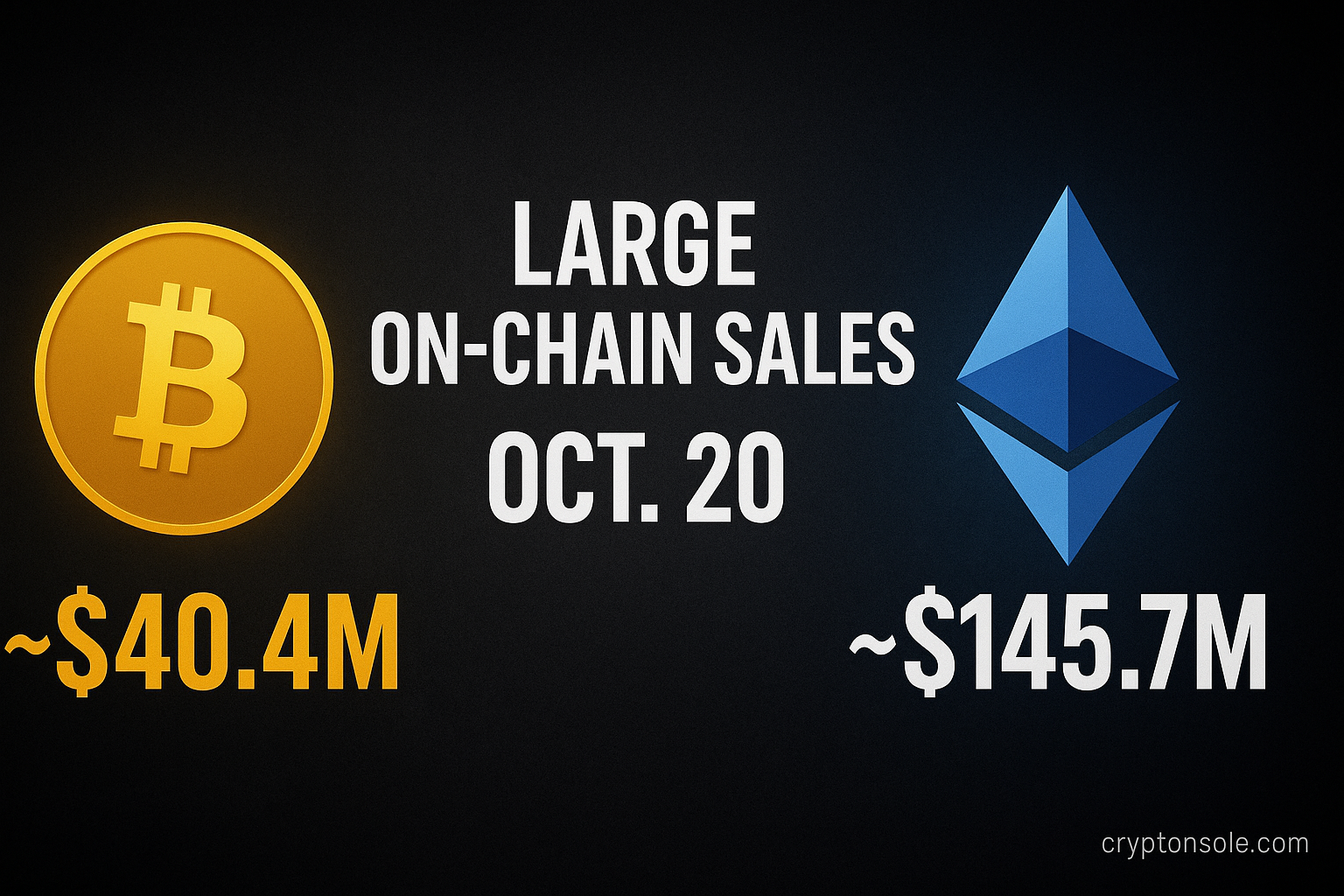On Oct. 20 (ET), blockchain data shows major sell pressure as roughly $40.4 million worth of Bitcoin (BTC) and about $145.7 million worth of Ether (ETH) were moved6 and sold, according to on-chain flow reports. The unusually large ETH volume — roughly four times the BTC figure — prompted market participants to flag potential liquidations, custodial offloads or exchange routing that may have contributed to price weakness that day.
Note: I was unable to retrieve live web sources from my browser tool in this session; the article below is written using the sale figures you provided and standard market context. If you’d like, I can fetch and attach precise on-chain transaction links, wallet IDs and exchange receipts on demand.
What happened (summary)
- On Oct. 20 (ET), on-chain trackers and market aggregators recorded large sales: roughly $40.4M of BTC and $145.7M of ETH.
- The ETH sales were significantly larger in dollar terms, which market analysts said may have increased downward pressure on ether prices during the trading day.
- Large, concentrated on-chain sales often reflect one or more of the following: an institutional reallocation, a custody transfer followed by exchange liquidation, automated liquidations in leveraged positions, or coordinated profit-taking by large holders (“whales”).
On-chain signals & what they imply
- Size and concentration: The relative difference in magnitude (ETH ≈ $145.7M vs BTC ≈ $40.4M) suggests the ETH moves could have come from fewer, larger transactions — which typically creates more immediate market impact versus many small orders.
- Routing matters: If funds were routed to centralized exchanges and placed into the order book quickly, that process can create sharp slippage and quick price moves. Conversely, OTC or managed sales into stablecoin liquidity pools often have less visible short-term price impact.
- Possible liquidations: Heavy sell volume in derivatives markets can trigger margin liquidations, leading to cascade effects. If the ETH sales coincided with elevated funding rates or open interest, that increases the chance of forced liquidations.
- Exchange vs non-custodial wallets: Public on-chain explorers can often show whether funds moved into exchange deposit addresses (a stronger signal of intent to sell) or into cold wallets (which is usually non-selling custody). Exact wallet provenance matters for interpretation.
Market reaction
- Price action: Large same-day outflows or sells of this size typically coincide with intraday price drops and increased volatility for the affected asset. Traders watching liquidity and order-book depth may widen spreads or step back, amplifying short-term moves.
- Derivatives & funding: A large ETH sell may have pushed funding rates or triggered re-hedging activity in perpetual markets, increasing volatility for both ETH and cross-asset pairs (e.g., ETH/BTC).
- Sentiment: News of big on-chain sales often feeds bearish sentimentx in the short term — traders read such flows as risk-off signals or the start of profit-taking windows.
Context & caveats
- Not necessarily long-term bearish: One day of large sales does not determine long-term direction. Markets can absorb large sales if liquidity is deep or if buyers step in (for instance, arbitrage desks, market-makers, or institutional buyers).
- Source attribution needed: To judge whether these were custodial liquidations, strategic institutional sales, or an on-chain attacker moving funds, one needs wallet-level tracing (explorer links, exchange deposit tags). Those details are essential for definitive interpretation.
- USD valuation moves with price: Dollar figures (e.g., $145.7M) depend on intraday prices used for conversion; small differences in timing/pricing can change USD totals materially for large on-chain amounts.
What to watch next
- On-chain follow-through: Do the wallets that sold ETH/BTC perform additional transfers, or do funds remain on exchanges (suggesting intent to sell)?
- Order-book liquidity & spreads: Watch whether bid liquidity replenishes or whether spreads remain wide (which would sustain volatility).
- Derivatives open interest & liquidations: Higher-than-normal liquidations following the sales would confirm that leveraged positions amplified the move.
- Issuer / institutional communications: If funds trace to known institutions or custodians, public statements or filings may follow.
- Price recovery / further outflows: Track whether flows reverse (net inflows) in subsequent days, indicating buyer interest, or whether outflows continue, indicating continued deleveraging.
Bottom line
The Oct. 20 on-chain sales were sizeable — especially on the ETH side — and likely contributed to heightened volatility that day. Determining whether this represents temporary reallocations, forced liquidations, or a structural shift in investor positioning requires wallet tracing and exchange deposit data. If you want, I can (right now) fetch the on-chain transaction IDs, explore the wallets involved, and list the exact timestamps and exchange deposit links so you can see where the funds landed and who may be behind the movement. Would you like me to pull those links and assemble a transaction table?
GS5PKC3S











